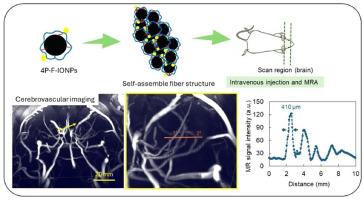Self-assembly of iron oxide nanoparticles for microvascular magnetic resonance imaging
IF 8.2
2区 材料科学
Q1 MATERIALS SCIENCE, MULTIDISCIPLINARY
引用次数: 0
Abstract
Iron-oxide nanoparticles (IONPs) are clinically used as stable contrast agents for magnetic resonance imaging. However, their application in microvascular imaging is limited because of their rapid diffusion across soft tissues and high accumulation in the liver. In this study, we present a self-assembled IONPs based contrast agent for cerebrovascular imaging. The IONPs were modified with fluorescein-conjugated 4-arm polyethylene glycol to prepare 4P-F-IONPs. Light-scattering analysis revealed that 4P-F-IONPs formed nanorod-like structures through self-assembly via fluorescein conjugation. Pharmacokinetic studies indicated longer blood circulation and reduced organ diffusion for the self-assembled nanorod contrast agent compared with pristine IONPs. Furthermore, microvasculature as small as 400 μm in diameter was clearly visualized after intravenous injection in a rat model. In contrast, the signals were not enhanced when 4P-IONPs (without fluorescein conjugation) were injected. These results suggest that fluorescein conjugation induces a structural transition in IONPs, which reduces contrast diffusion across micro-vessels and enhances the MR signals in the microvasculature.

用于微血管磁共振成像的氧化铁纳米颗粒的自组装
氧化铁纳米颗粒(IONPs)在临床上被用作磁共振成像的稳定造影剂。然而,它们在微血管成像中的应用受到限制,因为它们在软组织中的快速扩散和在肝脏中的高蓄积。在这项研究中,我们提出了一种自组装的基于IONPs的脑血管成像造影剂。用荧光素偶联的4臂聚乙二醇修饰IONPs,制备4P-F-IONPs。光散射分析表明,4P-F-IONPs通过荧光素偶联自组装形成纳米棒状结构。药代动力学研究表明,自组装纳米棒造影剂的血液循环时间较长,器官扩散减少。此外,在大鼠模型中,静脉注射后可以清晰地看到直径小至400 μm的微血管。相比之下,当注入4P-IONPs(没有荧光素偶联)时,信号没有增强。这些结果表明,荧光素偶联诱导离子离子束的结构转变,从而减少造影剂在微血管中的扩散,增强微血管中的MR信号。
本文章由计算机程序翻译,如有差异,请以英文原文为准。
求助全文
约1分钟内获得全文
求助全文
来源期刊

Materials Today Nano
Multiple-
CiteScore
11.30
自引率
3.90%
发文量
130
审稿时长
31 days
期刊介绍:
Materials Today Nano is a multidisciplinary journal dedicated to nanoscience and nanotechnology. The journal aims to showcase the latest advances in nanoscience and provide a platform for discussing new concepts and applications. With rigorous peer review, rapid decisions, and high visibility, Materials Today Nano offers authors the opportunity to publish comprehensive articles, short communications, and reviews on a wide range of topics in nanoscience. The editors welcome comprehensive articles, short communications and reviews on topics including but not limited to:
Nanoscale synthesis and assembly
Nanoscale characterization
Nanoscale fabrication
Nanoelectronics and molecular electronics
Nanomedicine
Nanomechanics
Nanosensors
Nanophotonics
Nanocomposites
 求助内容:
求助内容: 应助结果提醒方式:
应助结果提醒方式:


